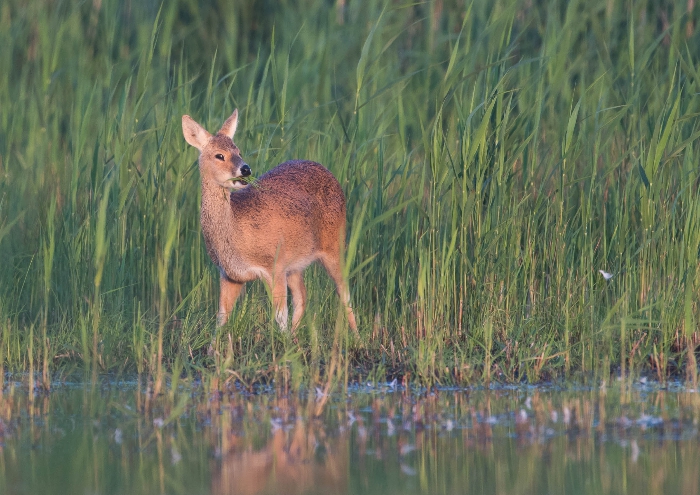Scientific name: Hydropotos inermis
Family: Cervidae
Appearance: Chinese Water Deer are small and compact deer, the males (bucks) have no antlers but have large canine teeth which look like tusks and protrude over the lower jaw. They are slightly larger than muntjac but are much lighter in colour. [Deer are our most-often confused species! If in doubt, please check out our Deer ID guide.].
Size: Height at shoulder 50-55cm; Head and body length 1m; Weight 11-20kg (males), 9-12kg (females)
Natural history: Chinese Water Deer were introduced into various zoos and deer parks in southern England in the late 19th and early 20th centuries. Escapes, releases and translocations have resulted in a wild population that inhabits mainly Norfolk, Bedfordshire and Cambridgeshire but is still spreading. As their name suggests they prefer wetland habitats such as reedbeds, riparian woodland and wet fenland. They feed on weeds and herbs and occasionally grasses. They are active throughout the day and night but there is a peak of activity around dawn and dusk.
They are largely a solitary species except during the mating season when they may form pairs or small groups. The rut occurs during November and December when bucks will fight for access to does and injuries are a common occurrence. The females give birth between May and July and can produce up to 5 kids, but between one and three is more common. The kids remain with their mother through the winter.

(C) Don Sutherland (shared under a CC BY-NC-ND 2.0 license)

 English (United Kingdom)
English (United Kingdom)  Czech (Čeština)
Czech (Čeština)  Nederlands (nl-NL)
Nederlands (nl-NL)  Magyar
Magyar  Deutsch (Deutschland)
Deutsch (Deutschland)  Croatian (Hrvatski)
Croatian (Hrvatski)  Polski (PL)
Polski (PL)  Español (España)
Español (España)